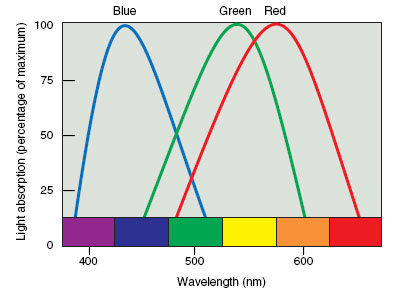Color vision
Color vision
Cones function to perceive color and require 50 to 100 times more light for stimulation than do rods. Consequently, night vision is almost totally rod vision. Unlike humans, who have both day and night vision, some vertebrates specialize for one or the other. Strictly nocturnal animals, such as bats and owls, have pure rod retinas. Purely diurnal forms, such as the common gray squirrel and some birds, have only cones; they are virtually blind at night.
In 1802 the English physician and physicist Thomas Young speculated that we see color by relative excitation of three kinds of photoreceptors: one each for red, green, and blue. In the 1960s Young’s prescient hypothesis was eventually supported through the combined work of several groups of researchers. Humans have three types of cones, each containing a visual pigment that responds to a particular wavelength of light (Figure 35-34). Blue cones absorb the most light at 430 nm, green cones at 540 nm, and red cones at 575 nm. Variation in the structure of opsin produces the different visual pigments found in rods and the three types of cones. Colors are perceived by comparing levels of excitation of the three different kinds of cones. For example, a light having a wavelength of 530 nm would excite green cones 95%, red cones about 70%, and blue cones not at all. This comparison is made both in nerve circuits in the retina and in the visual cortex of the brain, and the brain interprets this combination as green. Color vision occurs in some members of all vertebrate groups with the possible exception of amphibians. Bony fishes and birds have particularly good color vision. Surprisingly, most mammals are color blind; exceptions are primates and a few other species such as squirrels.
Cones function to perceive color and require 50 to 100 times more light for stimulation than do rods. Consequently, night vision is almost totally rod vision. Unlike humans, who have both day and night vision, some vertebrates specialize for one or the other. Strictly nocturnal animals, such as bats and owls, have pure rod retinas. Purely diurnal forms, such as the common gray squirrel and some birds, have only cones; they are virtually blind at night.
In 1802 the English physician and physicist Thomas Young speculated that we see color by relative excitation of three kinds of photoreceptors: one each for red, green, and blue. In the 1960s Young’s prescient hypothesis was eventually supported through the combined work of several groups of researchers. Humans have three types of cones, each containing a visual pigment that responds to a particular wavelength of light (Figure 35-34). Blue cones absorb the most light at 430 nm, green cones at 540 nm, and red cones at 575 nm. Variation in the structure of opsin produces the different visual pigments found in rods and the three types of cones. Colors are perceived by comparing levels of excitation of the three different kinds of cones. For example, a light having a wavelength of 530 nm would excite green cones 95%, red cones about 70%, and blue cones not at all. This comparison is made both in nerve circuits in the retina and in the visual cortex of the brain, and the brain interprets this combination as green. Color vision occurs in some members of all vertebrate groups with the possible exception of amphibians. Bony fishes and birds have particularly good color vision. Surprisingly, most mammals are color blind; exceptions are primates and a few other species such as squirrels.
 |
| Figure 35-34 The absorption spectrum of human vision. Three types of visual pigments in cones absorb maximally at 430 nm (blue cones), 540 nm (green cones), and 575 nm (red cones). |




